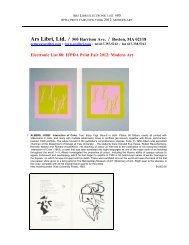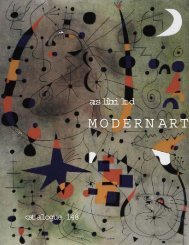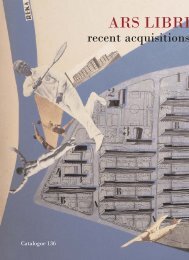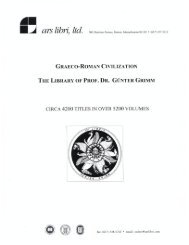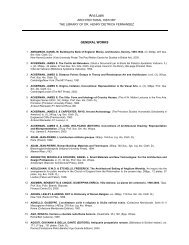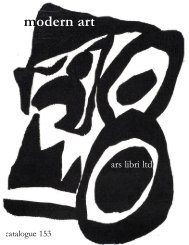Create successful ePaper yourself
Turn your PDF publications into a flip-book with our unique Google optimized e-Paper software.
and, later, persona non grata for his collaboration with the<br />
Vichy government, gets the cover’s most prominent credit<br />
for his essay here, but Brassaï’s 64 photos are the book’s<br />
real meat. Working at night, sometimes in the company of<br />
Raymond Queneau or Henry Miller (who gave the photographer<br />
a cameo role in his ‘Tropic of Cancer’) but often<br />
alone, Brassaï became a master at drawing luminosity from<br />
the darkness. The swaths of wet paving stones featured on<br />
the covers and endpapers of ‘Paris de nuit’ gleam like pale<br />
beacons in the streetlight. Inside, Brassaï explores the city,<br />
beginning with its broad vistas and grand public spaces and<br />
gradually moving into the demimonde he knew so intimately.<br />
The prostitutes, the rag pickers, the showgirls, the homeless—Brassaï<br />
juxtaposed them with pictures of Paris’s<br />
leisure class, with the Eiffel Tower strung with lights, and<br />
the Place de la Concorde ablaze” (Vince Aletti, in Roth).<br />
“Amongst the best produced and [most] influential photobooks<br />
ever. It demonstrates that the urban flâneur was a<br />
crucial figure in 1930s photography, perhaps as important<br />
as the social reformer. The book took a definitive step into<br />
new territories, which would be colonized by the likes of<br />
Weegee, Bill Brandt and others, and not least by Brassaï<br />
himself, when his ‘secret’ night work from Paris would<br />
eventually be widely published” (Parr/Badger). Tiny chips at<br />
edge of cover expertly retouched; an exceptionally fine and<br />
fresh copy of this fragile book.<br />
Paris (Édition Arts et Métiers Graphiques) [1933].<br />
$4,500.00<br />
Roth p. 76f.; Parr/Badger I, p. 134; The Open Book p. 110f.<br />
8<br />
BRETON, ANDRÉ<br />
Ode à Charles Fourier. (Collection “L’Age d’Or.”) 41, (7)pp.<br />
Illustrations and typographical ornaments throughout, printed<br />
in black (some after ink drawings in pen or brush). 4to.<br />
� rare books 5<br />
Dec. wraps. All contents loose, as issued. One of 175 numbered<br />
copies on heavy Marais Crèvecoeur, signed in the<br />
justification by André Breton, apart from the normal edition<br />
of 750 unsigned copies on vélin (and deluxe edition of 30);<br />
in all, 1025 copies were printed, “dessiné à New-York par<br />
Frederick J. Kiesler.” One of the most innovative and important<br />
publications of the postwar Paris/New York surrealist<br />
axis. A very fine copy.<br />
Paris (Éditions de la Revue Fontaine), 1947. $2,500.00<br />
Sheringham Aa381; Gershman p. 9; Ades 17.47; Biro/ Passeron<br />
455; Reynolds p. 18<br />
9<br />
BROCK, BAZON, et al.<br />
Bloom Zeitung. [Signed] Bazon Brock, Bernhard Jäger,<br />
Thomas Bayerle [Bayrle]. (4)pp. (single sheet, folding),<br />
printed in red and black. Numerous halftone photographs<br />
incorporated in the tabloid design of the recto; verso printed<br />
in black as a poster, with massive letters spelling “BLOOM.”<br />
548 x 750 (folding to 375) mm. (ca. 21 1/2 x 29 1/2 [folding<br />
to 14 3/4) inches. A faux issue of the “Bild-Zeitung,” retitled<br />
“Bloom Zeitung” in honor of Bloomsday—June 16th, the day<br />
commemorated in James Joyce’s “Ulysses”—and with the<br />
word “Bloom” substituted in every headline and every ad.<br />
“Bloom will Kanzler bleiben!,” “Bloom-Angst: Kinder laufen<br />
weg,” “Bloom is noch nicht gebannt.”<br />
Published on Bloomsday 1963 (59 years after Leopold<br />
Bloom’s odyssey in 1904), “Bloom Zeitung” was distributed<br />
throughout Frankfurt by Brock, Bayrle and Jäger, somewhat<br />
on the model of Yves Klein’s “Dimanche” of 1960. Brock,<br />
who cofounded the Deutsche Studenten Partei with Josef<br />
Beuys and Johannes Stüttgen at the Kunstakademie Düsseldorf,<br />
was one of the most prominent figures in Germany<br />
in the realm of happenings and performance in the 1960s;<br />
Bayrle and Jäger together ran the Gulliver Press between<br />
7



